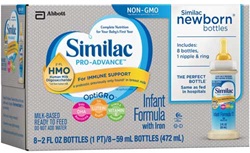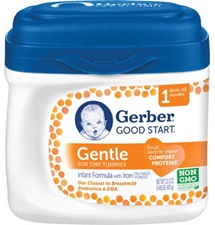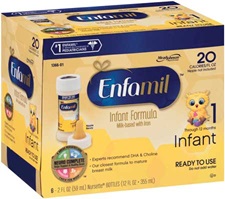Starting Babies off Right
FOOD SAFETY AND QUALITY
 Ensuring the health of babies begins before they are born with proper prenatal care for mothers and continues after birth with proper feeding of infants. The medical establishment considers breast milk the best food that babies should receive after they are born because it contains proteins, carbohydrates, and fats in the proper proportions to help meet infants’ nutritional needs; it is rich in essential nutrients that help support healthy growth and development; its proteins are easy to digest; it contains hundreds of prebiotics that help support digestive health and a healthy immune system; and it may protect against the development of some allergies. The American Academy of Pediatrics recommends that infants be exclusively breastfed for about the first six months with continued breastfeeding alongside introduction of complementary foods for at least one year. According to the Centers for Disease Control and Prevention (CDC), 81.1% of infants born in the United States in 2013 (the most recent data available) started with breastfeeding, 51.8% were breastfeeding at six months, and 30.7% were breastfeeding at 12 months. But for mothers who can’t breastfeed or don’t want to breastfeed, infant formula is the way to go.
Ensuring the health of babies begins before they are born with proper prenatal care for mothers and continues after birth with proper feeding of infants. The medical establishment considers breast milk the best food that babies should receive after they are born because it contains proteins, carbohydrates, and fats in the proper proportions to help meet infants’ nutritional needs; it is rich in essential nutrients that help support healthy growth and development; its proteins are easy to digest; it contains hundreds of prebiotics that help support digestive health and a healthy immune system; and it may protect against the development of some allergies. The American Academy of Pediatrics recommends that infants be exclusively breastfed for about the first six months with continued breastfeeding alongside introduction of complementary foods for at least one year. According to the Centers for Disease Control and Prevention (CDC), 81.1% of infants born in the United States in 2013 (the most recent data available) started with breastfeeding, 51.8% were breastfeeding at six months, and 30.7% were breastfeeding at 12 months. But for mothers who can’t breastfeed or don’t want to breastfeed, infant formula is the way to go.
The Federal Food, Drug, and Cosmetic Act defines infant formula as “a food which purports to be or is represented for special dietary use solely as a food for infants by reason of its simulation of human milk or its suitability as a complete or partial substitute for human milk.” The U.S. Food and Drug Administration (FDA) has established regulations that relate to the composition, efficacy, quality, production, and marketing of infant formulas in the United States and defines infants as persons not more than 12 months old.
According to the FDA, an estimated one million infants in the United States are fed infant formula from birth and that by three months of age about 2.7 million infants rely on infant formula for at least part of their nutrition. The Infant Formula Act enacted in 1980 and amended in 1986 plus the FDA’s infant formula regulations ensure the safety and nutritional value of infant formulas. The ingredients used in infant formulas must be generally recognized as safe (GRAS), meet the FDA’s food additive regulations, or be authorized by prior sanction. The scientific evidence mandated for documenting the safety of these ingredients includes chemical characterization, anticipated exposure level, and data from animal models and clinical studies.
There are two categories of infant formula: infant formula for healthy full-term infants and exempt infant formulas for infants with an inborn error of metabolism, low birth weight, or an unusual medical or dietary problem. All infant formula must contain the following 30 nutrients: protein, fat, linoleic acid, vitamin A, vitamin D, vitamin E, vitamin K, thiamin (vitamin B1), riboflavin (vitamin B2), vitamin B6, vitamin B12, niacin, folic acid, pantothenic acid, biotin, vitamin C (ascorbic acid), choline, inositol, calcium, phosphorus, magnesium, iron, zinc, manganese, copper, iodine, selenium, sodium, potassium, and chloride. The FDA has set minimum levels for all 30 nutrients and maximum levels for protein, fat, vitamin A, vitamin D, iron, iodine, selenium, sodium, potassium, and chloride.
The FDA does not approve infant formulas before they can be marketed. However, all infant formulas marketed in the United States must meet the nutrient requirements, and infant formula manufacturers must notify the FDA prior to marketing a new or modified formula. That notification must include evidence that the infant formula supports normal physical growth when fed as a sole source of nutrition. This can be achieved through acceptable clinical studies that demonstrate adequate growth, using standards advocated by the American Academy of Pediatrics and published by the CDC. The FDA completed 33 reviews of new infant formula notifications during fiscal year 2015 (October 2014 through September 2015) and 20 during fiscal year 2016 (October 2015 through September 2016).
In June 2014 the agency issued the final rule “Current Good Manufacturing Practices, Quality Control Procedures, Quality Factors, Notification Requirements, and Records and Reports, for Infant Formula,” which requires manufacturers of infant formula to use current good manufacturing practices specifically designed for infant formula, test for the presence of Salmonella and Cronobacter, demonstrate that the infant formulas support normal physical growth and that the protein component has sufficient biological quality, and test infant formulas for nutrient content before entering the market and at the end of the product’s shelf life.
The agency has also issued several guidance documents and draft guidance documents for manufacturers of infant formulas and exempt infant formulas, including “Demonstration of the Quality Factor Requirements Under 21 CFR 106.96(i) for ‘Eligible’ Infant Formulas” in June 2014; “Exempt Infant Formula Production: Current Good Manufacturing Practices (CGMPs), Quality Control Procedures, Conduct of Audits, and Records and Reports” in April 2016; “Labeling of Infant Formula” and “Substantiation for Structure/Function Claims Made in Infant Formula Labels and Labeling” in September 2016; and “Preparation of Food Contact Notifications for Food Contact Substances in Contact with Infant Formula and/or Human Milk” in December 2016. The FDA also maintains the webpage “Exempt Infant Formulas Marketed in the United States by Manufacturer and Category.”
Evaluating Ingredients
At the annual event of the Institute of Food Technologists (IFT) in July 2016, speakers presented the symposium “Infant Formula Nutrition: Regulatory and Safety Evaluation of Ingredients.” The speakers discussed infant formula regulations, the GRAS determination of ingredients, novel ingredients being considered for use in infant formula, and preclinical testing requirements. The introduction to the symposium emphasized that research continues to increase the understanding of human milk biology and its physiological functions in newborns and that the safety of some substances in human milk, such as immunoglobulins, cellular membranes, uniquely structured phospholipids, and complex carbohydrates, may require extensive research to ensure safety and efficacy on behalf of infants.
Carrie L. Assar, team leader, infant formula and medical foods staff, Center for Food Safety and Applied Nutrition, FDA, reviewed the regulations pertaining to infant formula and the premarket notification process. She said that in addition to meeting good manufacturing practices, liquid infant formula must comply with procedures for thermally processed low-acid foods packaged in hermetically sealed containers, and each production aggregate (formerly referred to as batch) of powdered infant formula must be tested for the presence of Cronobacter and Salmonella and be coded to enable tracing at all stages of manufacture. In addition, each nutrient premix and each production aggregate of infant formula must be tested for the content of all nutrients prior to release, she said. Shelf-life testing of the first production aggregate must be done for all nutrients except minerals every four months and at the end of the shelf life, and shelf-life testing of all subsequent production aggregates must be done for all nutrients except minerals at the end of the shelf life.
Assar described the notification process. Manufacturers wanting to market a new infant formula or an existing infant formula that has undergone a major change in formulation, processing, or packaging must notify the FDA 90 days before marketing the product. The notification must include the name and description of the product, the formulation, the effects of changed ingredients on nutrient levels, processing information, how the infant formula meets the quality factor requirements (normal physical growth and biological quality of the protein), compliance with nutrient content requirements, the basis for each ingredient’s meeting the safety and suitability requirements, and exemption requests, if applicable.
She said that the FDA conducts yearly inspections of all manufacturing facilities to determine whether they meet CGMPs, follow quality control procedures, and keep records and reports, including complaint records. The agency also inspects new facilities during early production runs and conducts special inspections as needed. If the FDA determines that an infant formula presents a risk to human health, it can initiate a mandatory recall.
Claire L. Kruger, president, ChromaDex Spherix Consulting, a Business Unit of ChromaDex, Inc., Rockville, Md. (chromadex.com), said that a GRAS determination for an infant formula ingredient must consider chemical or biological composition, supply chain control, production process, specifications, intended use and use levels, structure-activity relationships, and safety assessment using data derived from animal pharmacokinetic and toxicology studies and clinical trials.
She said that the safety standard for a GRAS ingredient is the same as that for food additives—reasonable certainty of no harm—and that evidence of safety is the same as that required to support approval of a food additive petition.
She emphasized that a GRAS evaluation for infant formula ingredients must rely on a risk assessment process that includes hazard identification, hazard characterization, exposure assessment, and risk characterization. The methods for assessing toxicity include computational toxicology, structure-activity relationships, in vitro tests, short-term and long-term animal bioassays, human studies, clinical trials, epidemiology, and post-marketing surveillance. And she described successful strategies employed in determining the GRAS status of canola oil used as a source of alpha-linolenic acid in infant formula, peroxidase derived from a genetically modified strain of Aspergillus niger used in infant formula, galacto-oligosaccharide, and lactoferrin derived from cow’s milk.
Roger A. Clemens, adjunct professor of pharmacology and pharmaceutical sciences, University of Southern California, said that recent innovations in infant formulas include technologies to reduce the allergenicity of cow’s milk and soy protein and the addition of docosahexaenoic acid (DHA) for improved cognitive development and visual acuity. He pointed out that breast milk is composed of carbohydrate (lactose and oligosaccharides), protein (casein and whey), and fats (cholesterol, linoleic acid, DHA, carnitine (which is important in fat metabolism), and lipase enzymes for fat digestion). He said that the human milk fat globule membrane (MFGM), a lipid fraction rich in phospholipids and cholesterol, contains more than 190 different proteins that may function as cell protectants, modulate cell signaling, and have anticancer and antimicrobial effects. He also said that since infant formulas use fat sourced from vegetable oils instead of milk fat, they contain no MFGM and that bovine MFGM, a byproduct of butter production with many similarities to human MFGM, may be beneficial to include in infant formula to aid in brain and cognitive development. Future innovations in formulation of infant formulas, he said, will require an increased understanding of human milk biology, infant physiology, and strategic, progressive clinical research.
Bjorn A. Thorsrud, assistant vice president and director of infant nutritional sciences, Experimur, Chicago (experimur.com), said that preclinical testing of novel ingredients for use in infant formula requires evaluation of their safety during the lactation period. Standard steps to evaluate the safety of infant formula include test material characterization (structure, stability, solubility), genetic tests, and cellular studies; well-established animal testing protocols to determine absorption, distribution, metabolism, and excretion of the substance; and acute, subchronic, chronic, and developmental and reproductive toxicity studies.
Thorsrud said that a number of different animal models are available for infant formula testing, including in vivo, in utero, in vitro, and in silico (computer modeling). He described the advantages and disadvantages of using various species for the testing, including rodents, dogs, primates, and pigs, and concluded that the neonatal piglet appears to be the most relevant research model for testing infant formulas because of the similarities in anatomy, physiology, dietary requirements, and immune system to those of human infants during the nursing period.
 Neil H. Mermelstein, IFT Fellow, Editor Emeritus of Food Technology
Neil H. Mermelstein, IFT Fellow, Editor Emeritus of Food Technology
[email protected]


 Abbott (
Abbott ( Gerber Products Co. (
Gerber Products Co. ( Mead Johnson Nutrition (
Mead Johnson Nutrition (